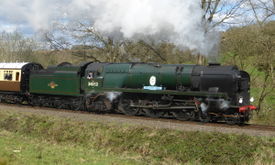Difference between revisions of "SR 34053 Sir Keith Park"
m |
m (Remove tautology) |
||
| Line 27: | Line 27: | ||
}} | }} | ||
| − | The SR West Country and Battle of Britain classes were designed by Oliver Bulleid, the CME of the Southern Railway (SR). Lighter | + | The SR 'West Country' and 'Battle of Britain' classes were designed by Oliver Bulleid, the CME of the Southern Railway (SR). Lighter than their sister locomotives, the Merchant Navy class, they could be used on a wider variety of routes including in the south-west of England and the Kent coast. They were a mixed-traffic design, being used for both passenger and freight trains, and were rated 7P6F by British Railways. |
Originally built with innovative features including air-smoothed casings and chain-driven valve gear, many of the locomotives including 34053 were rebuilt by British Railways in the late 1950s. | Originally built with innovative features including air-smoothed casings and chain-driven valve gear, many of the locomotives including 34053 were rebuilt by British Railways in the late 1950s. | ||
Revision as of 17:19, 11 December 2016
| SRSouthern Railway 34053 Sir Keith Park | |
|---|---|
 34053 at Highley in 2016 | |
| Built By | SRSouthern Railway Brighton Works |
| Configuration | 4-6-2 |
| BRBritish Rail or British Railways rating | 7P6F |
| Status | In Service |
| Loco Number | 34053 |
| Other Numbers | SRSouthern Railway 21C153 |
| History | |
| Built | 1947 |
| Designed By | Oliver BulleidOliver Vaughan Snell Bulleid, Chief Mechanical Engineer (CME) of the Southern Railway 1937-1948 |
| Type | SRSouthern Railway Battle Of Britain Class |
| 1966 | Withdrawn by BRBritish Rail or British Railways |
| 1984 | Left BarryWoodham Brothers Scrapyard, Barry, South Wales. The source of many locomotives now in preservation. |
| 2012 | Entered service on SVRSevern Valley Railway |
| Technical | |
| Length | 67ft 4¾" |
| Weight | 86t |
The SRSouthern Railway 'West Country' and 'Battle of Britain' classes were designed by Oliver BulleidOliver Vaughan Snell Bulleid, Chief Mechanical Engineer (CME) of the Southern Railway 1937-1948, the CMEChief Mechanical Engineer of the Southern Railway (SRSouthern Railway). Lighter than their sister locomotives, the Merchant Navy class, they could be used on a wider variety of routes including in the south-west of England and the Kent coast. They were a mixed-traffic design, being used for both passenger and freight trains, and were rated 7P6F by British Railways.
Originally built with innovative features including air-smoothed casings and chainAs a unit of measurement, 22 yards or 1/80th of a mile-driven valve gear, many of the locomotives including 34053 were rebuilt by British Railways in the late 1950s.
34053 Sir Keith Park in service
34053 was built in 1946 at the SRSouthern Railway’s Brighton Works and entered service as SRSouthern Railway no 21C153. It was originally allocated to Salisbury MPDMotive Power Depot but also worked from the Stewarts Lane depot, where it hauled prestige services such as the Golden Arrow on many occasions. In 1960 it was transferred to Bournemouth, where it often hauled the Pines Express on the Somerset & Dorset Railway.
34053 was withdrawn from service by BRBritish Rail or British Railways in October 1966 and towed to Woodham's scrapyard at BarryWoodham Brothers Scrapyard, Barry, South Wales. The source of many locomotives now in preservation. the following March.
34053 in preservation
34053 left BarryWoodham Brothers Scrapyard, Barry, South Wales. The source of many locomotives now in preservation. in 1984. Evidence of her time spent there can still be seen today in the form of the words "Sold Mr Woodham" which are visible on the lower left slide bar. After various owners and lengthy periods in store, restoration was finally completed by Southern Locomotives Limited in May 2012. Having no need of the locomotive at Swanage, agreement was reached for 34053 to come to the SVRSevern Valley Railway for an indefinite period. After some 'fine tuning' on arrival at Bridgnorth, 34053 entered service in August 2012.
See Also
Steam Locomotives
List of preservation groups
Links
Southern Locomotives Limited website
SR West Country and Battle of Britain class locomotives on Wikipedia
| ||||||||||||||||||||||||||||||||||||||||||||||||||||||||
